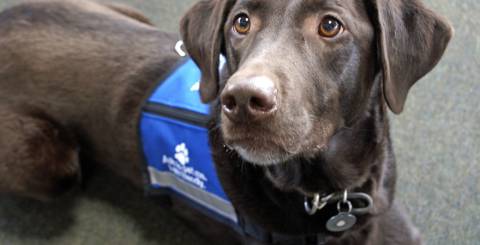Therapy Dog Requirements

You’ve probably heard about Therapy Dogs before. But do you know what they really are?
Unlikely. The term “therapy dogs” needs a lot of disambiguation, as people often confuse it with service dogs and emotional support dogs; and - while they all serve the basic principle of aiding humans - there are several aspects that are different from one classification to the other, both practical and even legal.
But we’re here for you. We’ll throw you a bone, buddy. Yes, you’re a good buddy, aren’t you? Let’s fetch it!
Emotional Support Dog vs Service Dog vs Therapy Dog
 Like we said, all three are different from regular dogs in the sense that they provide a special kind of aid to humans that regular dogs can’t. But there are several differences between them. Here’s a few:
Like we said, all three are different from regular dogs in the sense that they provide a special kind of aid to humans that regular dogs can’t. But there are several differences between them. Here’s a few:
Ownership: While emotional support dogs and service dogs have one owner to which they serve and live with, therapy dogs usually don’t. They are usually owned by an institution and serve several different people.
Training: While service dogs and therapy dogs go through extensive training to be certified as so, emotional support ones require no training.
Protection: Owners of emotional support dogs and service dogs have some privileges regarding their dogs because their aid is required at most times. That means, for instance, owners need not pay fees that regular dogs pay for air travel, as the passenger requires the dog with him/her to perform its duties during the flight. It’s considered a measure to make sure not only the pet owner is safe, but also the rest of the passengers. The same thing with housing; Landlords and Homeowners associations (HOA) cannot discriminate people with disabilities. After the Department of Housing and Urban Development’s Federal Housing Act, even if there was a no-pet restriction – and yes, HOA can impose pet restrictions – if the owner shows the documentation for the service dog and a letter from a physician/shrink about the emotional support dog, the Landlord or the HOA cannot deny him/her housing or even charge pet fees. Therapy Dogs don’t have that protection as - like we’ve mentioned - they are not owned by individual persons. Access to businesses like shopping stores, groceries, and even restaurants follow the same pattern.
Identification: This one is complex to explain. Let’s start with the easy one: Therapy dogs are always in a somewhat contained environment, so it needs no identification aside from the regular collar name tag every dog has. Now, when it comes to emotional support dogs and service dogs - since they are allowed to enter places regular dogs don’t – it gets complicated as the law prohibits businesses to inquire about a person’s disabilities. But how to know if that dog is a regular dog or an emotional support or a service dog? Service dogs usually are required to use a vest that proves they are service dogs. Some even have a transparent sleeve where a service dog ID is inserted, so when a clerk or a restaurant manager sees it, he (or she) automatically understands the situation and makes no questions about it. Now, if an emotional support one were to wear the same vest, the owner’s condition and fragilities would be exposed, which would only make him (or her) more aggravated by it. So, while the owner must have the documentation with them, should the clerk or restaurant manager feel the need, he/she can ask “Is this a service dog?” and it’s up for the owner to reply it, and, if necessary, show the documentation. But they can’t go beyond there, as they’ll be liable for discrimination charges just like it’s a crime for the owner to lie and say that an “undocumented” dog is an emotional support or a service dog.
So, summing up:
Service Dogs are dogs trained to perform tasks for humans with disabilities like visual impairments, seizure disorders, mental illness, diabetes and more. They are usually bought or “leased” by their owners and live with them at their house, under their responsibility. Their duty is to give some independence and safety to their owner. They can help blind people walk by guiding them, they can help people in wheelchairs by pushing the wheelchair, and even detect low blood pressure and epileptic seizures and position the owner in a way that their airways are unblocked so the owner doesn’t choke. Because of the complexity of their duties and the weight they usually need to carry, service dogs tend to be large dogs.
Very much like the name says, Emotional support dogs give psychological emotional support to its owner. It’s not trained – in fact, sometimes it can be kind of be naughty when it comes to behavior. But whether because of a trauma or whatever, its presence is required by the owner to feel at ease. Without the dog, the owner would feel tense, ashamed, depressed and could even have a psychotic outbreak. Since their support should be perceived by their owners and not necessarily anyone else, these dogs don’t have a particular character when it comes to breed and size etc. It can be one of the best guard dogs or a super mellow sleep-all-day pooch.
And therapy dogs are dogs that go through a lengthy therapy dog training to alleviate the anxiety of large groups. They are typically used in hospitals and hospices to comfort people through their affection and willingness to interact in a friendly and gentle way. You guessed it: although they can be of any breed if properly trained to socialize with new people, places and things and never being too agitated but super mellow and obedient, they are 9 out of 10 times Labradors and Golden Retrievers. Nowadays, even Universities have been using therapy dogs during final terms to alleviate the stress in their students, and big companies have been using them to alleviate their employers’ stress as well. Lately, therapy dogs have been tested on disaster areas to great success as a way to not only ease but entertain survivors.
Can a dog be all three at once? It’s rare, there are some certification offices that do not grant “dual licenses”, but you can technically have a dog that is your service dog for whatever reason, and you are so attached to it that it’s also your emotional support dog (though it will make no difference, as it has all the benefits already due to it being a service dog) and, on top of it all, this overachieving dog also went through the therapy dog training to provide this service from time to time to other people. But wow, does this dog ever rest?
Talking about rest… Phew! Now we are certain that you understand the difference between Emotional Support Dog vs Service Dog vs Therapy Dog; right?
However, we’re not done.
The theme of this article is Therapy Dogs only, and that’s because of an equation that adds the increasing stress of modern life to the success of therapy dogs on alleviating it. We believe the result of that equation is going to affect commercial real estate in many ways. If there’s demand, a lot of people will see it as an opportunity to make money. Can you imagine a Therapy Dog café? A place where people go to drink coffee and chill with therapy dogs that just walk around them being friendly? It’s proven that Millennials – the largest generational extract in the workforce right now and for the next good decade – cares more about the quality of their life than the material things, the amenities of a neighborhood, the place they live and work is an important issue for them, so it’s a sure-fire idea that would do good and we believe is going to be popular in the future. With it, regulations will be made so that both dogs and people are safe within that real estate and much more.
With that in mind, let’s talk about specific issues concerning therapy dogs:
Where to get a therapy dog?
Therapy dogs are not a product. It’s not a breed, a type of dog you go to a pet store and ask for. Well, not yet, at least. And the reason for that is that the Therapy Dog history is very recent.
It dates back to 1976 when Elaine Smith founded Therapy Dogs International (TDI) in New Jersey. A registered nurse, she noticed how well patients responded to the visit of a local Chaplain that had a sweet Golden Retriever which he brought along. Depressed patients would smile, non-verbal patients would even speak. So she decided to create a formal therapy dog training and certification so dogs could officially act in animal-assisted therapy comforting people in retirement homes, hospice, and other areas. To date, more than 24,000 dogs and handlers have registered with TDI. And that’s another important issue to understand when thinking where to get a therapy dog: they require handlers, so you couldn’t “buy” one. You’d have to pass through the certification process together with the pooch, as one of its pillars is the absolute obedience to its handler – the other being their health status, as they cannot transmit any disease or bacteria to people in hospitals and hospices, who normally have a weak immune system. In fact, they have to do annual exams to make sure their health is 100%.
So, the “where” in “where to get a therapy dog” should be replaced by “how”, and the answer is through therapy dog training.
There are several organizations that provide therapy dog training, and they aim to make sure the pet won’t be scared of sudden movements, weird surfaces, and un-familiar movement and or shapes – for instance, they won’t bark at people in wheelchairs, people using canes, or with body deformities. Therapy dog training makes sure they’ll be polite even to strangers, and will not be judgmental to them. A remarkable program is R.E.A.D. (Reading Education Assistance Dogs) which promotes literacy and communication skills by making children read out loud to therapy dogs – that are trained to listen without being judgmental; and even give a big lick once the student is done.
If you’re curious about therapy dog training, click on this link to find all the American Kennel Club (AKC) recognized organizations that provide therapy dog training in the USA.
Therapy dog requirements
There are no therapy dog requirements in the sense that there are no special breeds or size. But, while the therapy dog training does work to make sure the dog gets transformed into an even more sociable dog, there are personality traits that are fundamental to the function and may rule a dog out of the process.
The main therapy dog requirements are obedience, like we’ve said, but also a calm nature. Their mission is to soothe patients and lower their blood pressure. Well-trained ones can even sense if the patient’s blood pressure is abnormal and proactively go to them as if it was saying “Hey, Buddy. Wanna talk?”. So if your dog had aggressive episodes in the past it might be harder for the organizations to train it and they might not certify the dog. Also, it will do no good if the dog is calm and obedient but never interacts, prefers to be on his own; being friendly and sociable is also a therapy dog requirement. In a way, their job is being petted, hugged and kissed – eventually giving back. All of this, worth noting, despite the environment in which they are in. Little angels, those dogs.
How much does a Therapy Dog cost?
To figure out how much does a Therapy Dog cost, you have to figure out which institution are you choosing - prices will vary from area to area. However, therapy dog training can be found for as low as $150 dollars plus registrations fees of about $50 dollars. But remember that the pooch must have all medical records up to date, so it will require you to go to the vet and spend a bit more. So, all in all, to start, we’re talking about $1,000 dollars max. And a lot of time on your end, as each therapy dog training session can take up to 2 hours and after the weeks of training, there are about 50 visits from Certification Officers to you and your therapy dog to assert you guys are following the therapy dog requirements.
As you can see, therapy dogs are really special and their influence in the assistance to humans can create legs and forge a whole new ballpark for humanity. If you’re deciding to bring a dog into your home, maybe adopt a therapy dog (should you, by any chance, get lucky to find one for adoption with that previous experience - being so valuable as they are, it’s very unlikely but one can dream).
To close, like our 4 legged friends say, “woof woof woof” – or “hope you liked our article and share it with your friends!”. See you next time!
Similar Articles
Is dog training a necessity or a luxury? Learn why training is crucial for a harmonious bond with your canine companion
Freeze-dried dog food is a relatively new player in the pet nutrition market. Unlike traditional kibble, freeze-dried food retains the nutritional value of fresh ingredients through a unique preservation method
Discover the latest nutritional trends in dog food and what pet owners need to know to keep their furry friends healthy and happy.
Pets are not simply creatures; they are treasured individuals from our families, meriting the most ideal consideration. A comprehensive way to deal with pet consideration perceives that their prosperity envelops something beyond actual well-being. It considers their psychological, profound, and social requirements too
When it comes to taking our beloved furry friends for walks, ensuring they are properly fitted with a dog harness and leash set is crucial for their safety and comfort. However, with so many options available in the market, it can be overwhelming to choose the right one and know how to properly fit it.
When did you last take your beloved pups to a pet grooming clinic? No matter how busy you are, you need to take time when it comes to dog grooming, you need to take time to bring your fur baby to the nearest PetSmart clinic. You need to maintain your dog's level of cleanliness as much as you take care of yourself.
Don’t we all love our little canine friends? Dogs are said to be the best friends of humans. They are the little paws that energetically roam around your house and that embrace you with those jumpy, and excited hugs, and let us not forget those warm welcomes that you get on a daily basis without a miss!
Just like humans, a dog’s health can suffer if they experience weight problems. Being either underweight or overweight can carry certain risks for a dog, so it’s important that you recognise and address any issues.
Spring is the height of household pet shedding. The warmer weather brings less of a need for a thick furry coat. As shedding amps up so does the amount of pet hair all over your home. Here are some tricks to help keep shedding under control and pet hair off of every surface in your home.









